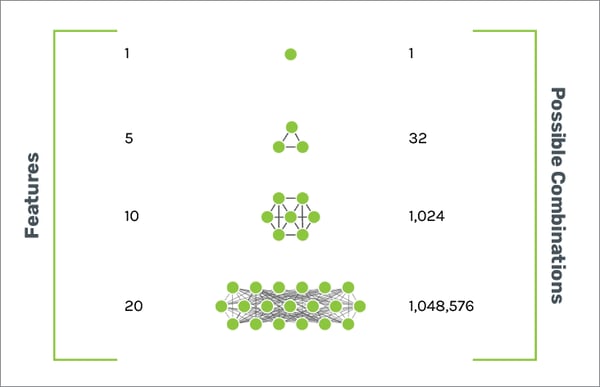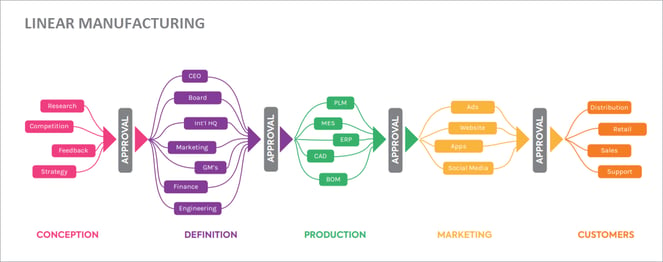
Product planners are like artists. They interpret and translate customer needs into product requirements. Unfortunately, they spend so much time managing the product requirements process that they don’t have as much time to truly innovate.
Product planners, particularly planners of hard goods, are held back by process inefficiencies and linear manufacturing processes. These are time-consuming administrative roadblocks. Alleviating these constraints gives product planners more time to be creative, consider more options that may resonate with consumers, and come up with more profitable products. First, let's understand these barriers more in-depth.
Process Inefficiencies
The first step in manufacturing a successful product is accurately defining it. Defining a product’s desired features while communicating this function efficiently is not only a complex and vital task, it requires real-time collaboration among product, marketing, engineering, and every department a new product will impact.
Inefficiencies impeding product planner innovation include:
- Inflexible linear manufacturing and production processes
- Delayed and drawn-out review and approval processes
- Single point of data management leading to inefficient and lengthy processes
- Lag/delay in sharing data in a predominately offline process
- Limitations on running different product configuration scenarios
- Inability to analyze variants against competitor data
DOWNLOAD: Reducing Complexity & Financial Waste in Product Manufacturing
Linear Manufacturing & Production Processes
Making the right decisions - the decisions that will connect with buying customers - saves money and reduces waste. Most product planners have to rely on siloed data and rigid structures. They are not free to capture ideas and model and evaluate products properly. Usually, this leads them to select variants out of a host of options and essentially guesstimate that those will fulfill consumer needs.
Why is this not more of an exact science?
Here's the scale of the problem: let's say you are considering offering a product that will have 6 colors, come in 4 sizes, and have a selection of optional upgrades and packages. The math works out to be: 6 x 4 x n options x n packages. It is an exponential problem - technically, it’s a factorial problem. The number of proposed buildable combinations can get quickly out of hand.

Product planners must have the tools to evaluate as many options as possible, including competitor data, to innovate and connect to consumers. This vital need can be seen clearly within the automotive industry, where millions (even billions) of dollars are invested into new models. When those new models fail to quickly connect with buyers, it does not take long for the model to be axed and a whole lot of money, time, and potentially jobs lost.
New E-book: Reducing Complexity & Financial Waste in Product Manufacturing
Product Planner Tools
The Right Tools For The Job
Product planners can spend less time in tools and processes and more time discovering what customers need and are willing to pay for. This balancing act is their art form.
Product planners need:
- The ability to run more what-if scenarios
- A platform to communicate to teams in real-time
- More time to communicate product definitions to designers and engineers
Infinite Flexibility
Getting product planners out of rigid tools and processes and into a cloud-based non-linear process allows them to run almost any kind of scenario. It gives them infinite flexibility to understand their product in different ways; to visualize, analyze, and run reports of different data sets easily and frequently. This allows them to make better decisions.
Infinite flexibility allows product planners to run product walks against endless combinations with different configurations and variants, be it color options, cost options, size options, and etc. This powerful ability lets planners do product walks like never before, to include running competitor scenarios, without any effort in generating the combinations.
How we can help!
Gocious helps product planners spend more time on the art form of innovating products that will resonate better with consumers once they hit the market. We champion the work product planners do in being creative by giving them the tools to better weigh and consider variants.
Traditional linear planning is restrictive and is not optimized for very good change management.

Our product decision analytics platform allows product planners to:
- Collaborate more efficiently on what the product definition is
- Catch problems on paper before ideas are sent to production
- Run more what-if configuration scenarios
- Take more time to educate engineering on the product definition and not just rely on using marketing requirement docs (MRDs), which can leave requirements murky
- React quicker to changes in the market landscape when things like COVID or other supply chain and consumer disruptions occur

Gocious helps hard goods manufacturers make better decisions about their complex products through a product decision analytics platform. We give product planners real-time product line analytics to make more insightful decisions on multi-variant products. The platform features infinite flexibility, data visualization, data import and export, robust security, and easy collaboration.
To learn more about how we help product planners, please visit our product page.
Additional Resources:
5 Things Learned About Rapid Product Development From COVID-19
How To Tap Into Customer Needs When Product Planning
Manage Product Complexity and Increase Speed to Market
5 Tips To Better Align New Products To Customers



